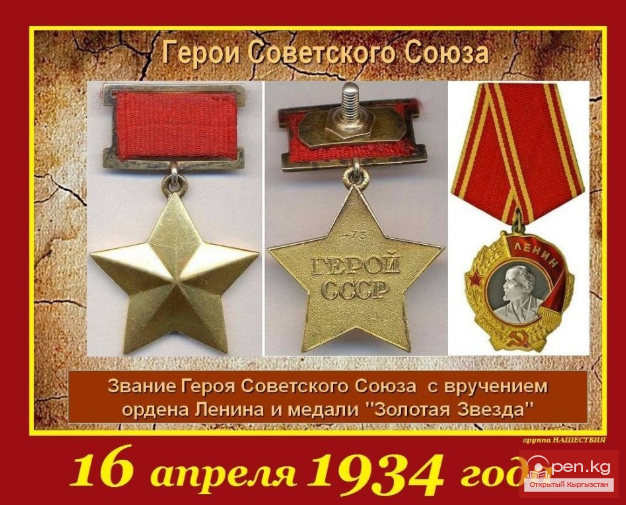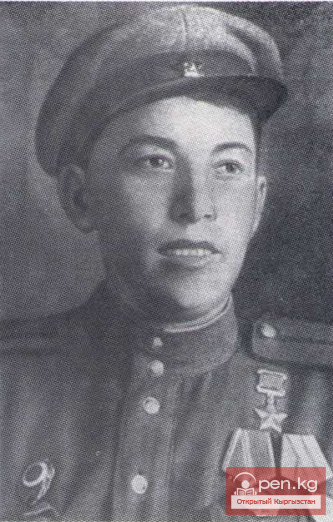The Title "Hero of the Soviet Union"
The highest degree of distinction - the title "Hero of the Soviet Union" was established by the Resolution of the Central Executive Committee of the USSR on April 16, 1934. The Resolution of the Central Executive Committee of the USSR approved the Regulation on the title of Hero of the Soviet Union, and by the Decree of the Presidium of the Supreme Soviet of the USSR on August 1, 1939, the medal "Golden Star" was instituted.
By the Decree of the Presidium of the Supreme Soviet of the USSR on May 14, 1973, the Regulation on the title of Hero of the Soviet Union was approved in a new edition. This Regulation states:
1. The title of Hero of the Soviet Union is the highest degree of distinction and is awarded for personal or collective merits before the state related to the accomplishment of a heroic deed.
2. The title of Hero of the Soviet Union is awarded by the Presidium of the Supreme Soviet of the USSR.
3. The Hero of the Soviet Union is awarded: the highest award of the USSR - the Order of Lenin; a badge of special distinction - the medal "Golden Star"; a certificate from the Presidium of the Supreme Soviet of the USSR.
4. A Hero of the Soviet Union who performs a heroic deed a second time, no less than that for which others who performed a similar deed are awarded the title of Hero of the Soviet Union, is awarded the Order of Lenin and a second medal "Golden Star," and in commemoration of his deeds, a bronze bust of the Hero with the appropriate inscription is erected in his homeland, which is recorded in the Decree of the Presidium of the Supreme Soviet of the USSR on the award.
5. A Hero of the Soviet Union awarded two medals "Golden Star" for new heroic deeds similar to those previously accomplished may be reawarded the Order of Lenin and the medal "Golden Star."
6. When awarding the Hero of the Soviet Union the Order of Lenin and the medal "Golden Star," he is simultaneously presented with a certificate from the Presidium of the Supreme Soviet of the USSR along with the order and medal.
7. In the event that the Hero of the Soviet Union is awarded the title of Hero of Socialist Labor, a bronze bust of the Hero with the appropriate inscription is erected in his homeland in commemoration of his heroic and labor deeds, which is recorded in the Decree of the Presidium of the Supreme Soviet of the USSR on the awarding of the title of Hero of Socialist Labor.
Heroes of WWII
Internationalist Heroes
Full Knights of the Order of Glory
These are privates and sergeants of the Soviet Army who, through their military labor and heroism, defended the homeland in battles and earned the grateful memory of descendants. The Order of Glory was established on the same day as the Order of "Victory" - November 8, 1943. It became the last of the "land" orders created during the war: after it, only the "naval" orders of Ushakov and Nakhimov appeared. The order had several features that no other domestic award had. Firstly, it is the only combat distinction intended for awarding exclusively soldiers and sergeants (in aviation, also junior lieutenants). Secondly, the awarding was carried out only in ascending order, starting from the lowest - III degree. Thirdly, until 1974, the Order of Glory was the only order of the USSR awarded solely for personal merits and never awarded to military units, enterprises, or organizations. Fourthly, the statute of the order provided for the promotion of knights of all three degrees in rank, which was an exception to the Soviet award system. It is worth noting that one of the elements of the order became the George - Guard ribbon.
The Order of Glory is awarded for:
• being the first to break into the enemy's position, contributing to the success of the common cause with personal bravery;
• while in a burning tank, continuing to carry out the combat mission;
• in a moment of danger, saving the Banner of his unit from capture by the enemy;
• using personal weapons to accurately shoot down from 10 to 50 enemy soldiers and officers;
• in battle, using an anti-tank rifle, disabling at least two enemy tanks;
• destroying from one to three tanks with hand grenades on the battlefield or in the enemy's rear;
• destroying at least three enemy aircraft with artillery or machine gun fire;
• disregarding danger, being the first to break into the enemy's pillbox (bunker, trench, or dugout), decisively destroying its garrison;
• as a result of personal reconnaissance, identifying weak points in the enemy's defense and leading our troops into the enemy's rear;
• personally capturing an enemy officer;
• at night, removing an enemy guard post (patrol, sentry) or capturing it;
• personally, with ingenuity and courage, sneaking up to the enemy's position, destroying his machine gun or mortar;
• being on a night raid, destroying an enemy supply depot with military property;
• risking his life, saving a commander in battle from immediate danger;
• neglecting personal danger, capturing an enemy flag in battle;
• being wounded, returning to duty after treatment;
• using personal weapons to shoot down an enemy aircraft;
• destroying enemy firepower with artillery or mortar fire, ensuring the successful actions of his unit;
• under enemy fire, creating a passage for the advancing unit through the enemy's wire obstacles;
• risking his life, under enemy fire, providing assistance to the wounded during several battles;
• while in a damaged tank, continuing to carry out the combat mission from the tank's weapons;
• rushing into the enemy's column with his tank, crushing it and continuing to carry out the combat mission;
• using his tank to crush one or several enemy guns or destroying at least two machine gun nests;
• while on reconnaissance, obtaining valuable information about the enemy;
• a fighter pilot destroying from two to four enemy fighter aircraft or from three to six bomber aircraft in aerial combat;
• an attack pilot destroying from two to five enemy tanks or from three to six locomotives, or blowing up a train at a railway station or on a stretch, or destroying at least two aircraft at the enemy's airfield;
• an attack pilot destroying one or two enemy aircraft in aerial combat as a result of bold initiative actions;
• the crew of a daytime bomber destroying a railway train, blowing up a bridge, a munitions depot, fuel, destroying the headquarters of an enemy unit, demolishing a railway station or stretch, blowing up a power station, blowing up a dam, destroying a military vessel, transport, boat, destroying at least two aircraft at the enemy's airfield;
• the crew of a light night bomber blowing up a munitions depot, fuel, destroying the enemy's headquarters, blowing up a railway train, blowing up a bridge;
• the crew of a long-range night bomber demolishing a railway station, blowing up a munitions depot, fuel, destroying a port facility, destroying marine transport or a railway train, demolishing or burning an important factory or plant;
• the crew of a daytime bomber for a bold action in aerial combat, resulting in the downing of one or two aircraft;
• the crew of a reconnaissance aircraft for successfully completing reconnaissance, resulting in valuable data about the enemy.
Full Knights of the Order of Glory
Special Sign "Ak Shumkar" for the Highest Degree of Distinction "Hero of the Kyrgyz Republic"

The Law of the Kyrgyz Republic "On State Awards and Honorary Titles of the Kyrgyz Republic"
1. The highest degree of distinction of the Kyrgyz Republic "Hero of the Kyrgyz Republic" is awarded to citizens for special merits before the state and society related to a deed accomplished in the name of freedom, independence, and prosperity of the Kyrgyz Republic.
2. The highest degree of distinction "Hero of the Kyrgyz Republic" is awarded once with the presentation of the special sign "Ak Shumkar" and the corresponding certificate.
3. The special sign "Ak Shumkar" is worn on the left side of the chest above the orders and medals of the Kyrgyz Republic.
Approved by the Decree of the President of the Kyrgyz Republic
on July 10, 1996, No. 234
Mothers whose children have been awarded the highest degree of distinction "Hero of the Kyrgyz Republic" are presented with the Order "Mother-Heroine".
DESCRIPTION of the special sign "Ak Shumkar"
The special sign "Ak Shumkar" is made of gold and represents a symmetrical star consisting of eight upper-level rays forming a circle with a diameter of 40 millimeters, and sixteen lower-level rays forming a circle with a diameter of 30 millimeters.
The outlines of the rays, facets, and the shape of the star resemble mountain peaks and blossoming mountain tulips.
In the central part of the star, there is a silver overlay framed by a laurel wreath. In the center of the overlay is a relief image of the sacred "Ak Shumkar" on a gilded background.
The ribbon is presented in the form of a tumar (an ancient Kyrgyz triangular-shaped talisman), where a relief drawing of a tündük is placed on a red enamel field.
The ribbon and the star are connected by a system of links. On the reverse side of the star, the number of the sign is engraved, and on the reverse side of the ribbon - a pin-type clasp.
Heroes of Kyrgyzstan













































